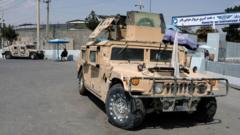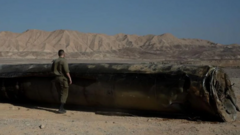Recent reports indicate that vast amounts of US military weaponry abandoned in Afghanistan have been either lost, sold, or smuggled to extremist groups, raising serious security concerns and highlighting potential future conflicts.
Weapons Left by US in Afghanistan Fuel Global Instability, Sources Reveal

Weapons Left by US in Afghanistan Fuel Global Instability, Sources Reveal
Half a million arms unaccounted for, sparking fears of militant access in multiple regions.
A troubling report from sources who spoke to the BBC has revealed that the Taliban has lost track of approximately half a million US-funded weapons since regaining control over Afghanistan in 2021. The cache includes advanced military equipment seized during the withdrawal of US forces, leading to fears that these arms may be circulating among various militant factions, including known affiliates of al-Qaeda.
The Taliban has claimed control of nearly one million weapons and pieces of military equipment, including American-made firearms like M4 and M16 rifles, as well as older stockpiles from Afghanistan’s prolonged conflicts. Notably, many Afghan soldiers either abandoned their posts or surrendered, leaving equipment behind as the Taliban advanced, combined with a significant number of items left by US forces.
During a closed-door session of the UN Security Council's Sanctions Committee, Taliban representatives admitted that at least fifty percent of these arms are currently "unaccounted for." UN reports corroborate claims that affiliated groups, such as Tehreek-e-Taliban Pakistan and Yemen's Ansarullah movement, are accessing or purchasing these weapons via black market channels.
In response to the escalating situation, Hamdullah Fitrat, the Taliban's deputy spokesperson, fiercely denied any claims of smuggling or loss, asserting they take the security of their armaments seriously. In contrast, the 2023 UN report revealed that Taliban commanders are allowed to retain a significant portion of seized weapons, thus fostering a thriving black market.
A former journalist from Kandahar has indicated that open arms marketplaces have transitioned from visible to hidden platforms, primarily utilizing WhatsApp for transactions among local commanders and affluent traders dealing in captured military equipment. These operations exemplify the ongoing chaos and challenges in effectively accounting for US-supplied hardware.
While the US-imposed oversight on military equipment, managed by the Office of the Special Inspector General for Afghanistan Reconstruction (SIGAR), states that they are unable to ascertain the exact number of items remaining, the issue remains tightly tied to bureaucratic shortcomings in tracking equipment given to Afghanistan.
Adding a political tone to the matter, former President Donald Trump has publicly stated his intentions to reclaim military equipment left in Afghanistan, estimating it at around $85 billion. Critics, however, dispute this figure, arguing it includes training and salaries unrelated to physical materiel. The Taliban, on the other hand, stands resolute in their decree, rejecting claims about smuggling while asserting that they have legitimate control over these arms.
As the situation unfolds, concerns grow regarding the ramifications of these arms potentially being utilized against domestic and regional threats, raising critical questions about future security in Afghanistan and its neighboring countries. The Taliban’s adeptness in showcasing captured US weaponry poses both a symbolic victory for their regime and a daunting challenge for international efforts to ensure stability in a volatile region.





















